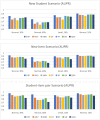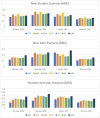Comparing the prediction performance of item response theory and machine learning methods on item responses for educational assessments
- PMID: 35819719
- PMCID: PMC9275388
- DOI: 10.3758/s13428-022-01910-8
Comparing the prediction performance of item response theory and machine learning methods on item responses for educational assessments
Abstract
To obtain more accurate and robust feedback information from the students' assessment outcomes and to communicate it to students and optimize teaching and learning strategies, educational researchers and practitioners must critically reflect on whether the existing methods of data analytics are capable of retrieving the information provided in the database. This study compared and contrasted the prediction performance of an item response theory method, particularly the use of an explanatory item response model (EIRM), and six supervised machine learning (ML) methods for predicting students' item responses in educational assessments, considering student- and item-related background information. Each of seven prediction methods was evaluated through cross-validation approaches under three prediction scenarios: (a) unrealized responses of new students to existing items, (b) unrealized responses of existing students to new items, and (c) missing responses of existing students to existing items. The results of a simulation study and two real-life assessment data examples showed that employing student- and item-related background information in addition to the item response data substantially increases the prediction accuracy for new students or items. We also found that the EIRM is as competitive as the best performing ML methods in predicting the student performance outcomes for the educational assessment datasets.
Keywords: Background information; Educational assessment; Explanatory item response model; Item response theory; Machine learning; Prediction performance.
© 2022. The Psychonomic Society, Inc.
Conflict of interest statement
The authors declared no potential conflicts of interests with respect to the research, authorship and/or publication of this article.
Figures








Similar articles
-
State-Aware Deep Item Response Theory using student facial features.Front Artif Intell. 2024 Jan 4;6:1324279. doi: 10.3389/frai.2023.1324279. eCollection 2023. Front Artif Intell. 2024. PMID: 38239499 Free PMC article.
-
A report on the piloting of a novel computer-based medical case simulation for teaching and formative assessment of diagnostic laboratory testing.Med Educ Online. 2011 Jan 14;16. doi: 10.3402/meo.v16i0.5646. Med Educ Online. 2011. PMID: 21249173 Free PMC article.
-
Role of convolutional features and machine learning for predicting student academic performance from MOODLE data.PLoS One. 2023 Nov 8;18(11):e0293061. doi: 10.1371/journal.pone.0293061. eCollection 2023. PLoS One. 2023. PMID: 37939093 Free PMC article.
-
A Web-based geriatrics portfolio to document medical students' learning outcomes.Acad Med. 2002 Sep;77(9):937-8. doi: 10.1097/00001888-200209000-00043. Acad Med. 2002. PMID: 12228110 Review.
-
Potential Future Directions in Optimization of Students' Performance Prediction System.Comput Intell Neurosci. 2022 May 17;2022:6864955. doi: 10.1155/2022/6864955. eCollection 2022. Comput Intell Neurosci. 2022. PMID: 35619762 Free PMC article. Review.
Cited by
-
Intervention on Mathematics Self-Efficacy: Solution-Focused Brief Therapy.Psychol Res Behav Manag. 2024 Jan 9;17:129-145. doi: 10.2147/PRBM.S432569. eCollection 2024. Psychol Res Behav Manag. 2024. PMID: 38223311 Free PMC article.
References
-
- Altman NS. An introduction to kernel and nearest-neighbor nonparametric regression. American Statistician. 1992;46(3):175–185. doi: 10.1080/00031305.1992.10475879. - DOI
-
- Anderson JO, Lin H, Treagust DF, Ross SP, Yore LD. Using large-scale assessment datasets for research in science and mathematics education: Programme for international student assessment (PISA) International Journal of Science and Mathematics Education. 2007;5(4):591–614. doi: 10.1007/s10763-007-9090-y. - DOI
-
- Bates D, Maechler M, Bolker B, Walker S. lme4: Linear mixed-effects models using Eigen and S4. R package version. 2014;1:1–17.
-
- Bergner, Y., Droschler, S., Kortemeyer, G., Rayyan, S., Seaton, D., & Pritchard, D. E. (2012). Model-based collaborative filtering analysis of student response data: Machine-learning item response theory. International Educational Data Mining Society.
-
- Breiman L. Random forests. Machine Learning. 2001;45(1):5–32. doi: 10.1023/A:1010933404324. - DOI
MeSH terms
LinkOut - more resources
Full Text Sources
Other Literature Sources

